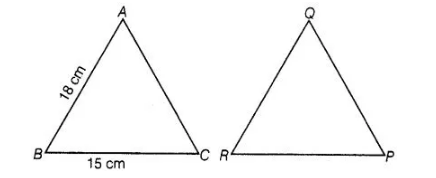If $\triangle A B C \sim \triangle Q R P, \frac{\operatorname{ar}(\triangle A B C)}{\operatorname{ar}(\Delta P Q R)}=\frac{9}{4}, A B=18 \mathrm{~cm}$
and $B C=15 \mathrm{~cm}$, then $P R$ is equal to
(a) $10 \mathrm{~cm}$
(b) $12 \mathrm{~cm}$
(c) $\frac{20}{3} \mathrm{~cm}$
(d) $8 \mathrm{~cm}$
(a) Given, Δ ABC ~Δ QRP, AB = 18cm and BC = 15cm

We know that, the ratio of area of two similar triangles is equal to the ratio of square of their corresponding sides.
$\therefore$ $\frac{\operatorname{ar}(\Delta A B C)}{\operatorname{ar}(\Delta Q R P)}=\frac{(B C)^{2}}{(R P)^{2}}$
But given, $\frac{\operatorname{ar}(\Delta A B C)}{\operatorname{ar}(\Delta P Q R)}=\frac{9}{4}$ [given]
$\Rightarrow$ $\frac{(15)^{2}}{(R P)^{2}}=\frac{9}{4}$ $[\because B C=15 \mathrm{~cm}$, given]
$\Rightarrow$ $(R P)^{2}=\frac{225 \times 4}{9}=100$
$\therefore$ $R P=10 \mathrm{~cm}$
Click here to get exam-ready with eSaral
For making your preparation journey smoother of JEE, NEET and Class 8 to 10, grab our app now.
